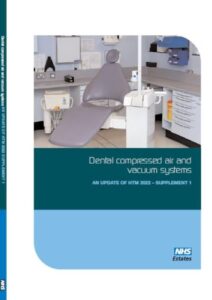Dental compressed air and vacuum systems An Update of HTM 2022 – Supplement 1
Dental compressed air and vacuum systems An Update of HTM 2022 – Supplement 1
The Supplement Dental compressed air and vacuum systems should be followed for all new installations and refurbishment; existing installations should be assessed for compliance with this Supplement. Where necessary, a plan for upgrading the existing systems should be prepared, taking into account the priority for patient and staff safety and statutory requirements which may have become effective subsequent to any existing installations. Owners, occupiers, general managers and chief executives should ensure that the premises for which they have responsibility and any activities carried out there in comply with these statutory requirements. This compliance is obligatory.
You can also Read Health Technical Memorandum 02-01- Medical gas pipeline systems Part A- Design, installation, validation and verification
Dental compressed air and vacuum systems supplied via a compressor, and fitted with an air-intake filter and a post compression filtration and dryer system. This ensures that the air is clean and dry, minimizing the risk of contamination of the system by micro-organisms and improving the efficiency of dental instruments.
• The dryer system should be capable of producing air with an atmospheric dew-point not less than –20ºC.
• The filter system should provide dust filtration down to 1 μm with a DOP (aerosol) efficiency of not less than 99.97% and bacteria filtration down to 0.01 μm with a DOP (aerosol) efficiency of not less than 99.9999%.
Update of HTM 2022 – Supplement 1 Content
- Executive summary
![Dental compressed air and vacuum systems Dental compressed air and vacuum systems]()
- Acknowledgements
- Scope
- Management responsibilities and guidelines
- Dental compressed air systems
- Dental vacuum systems
- Validation and verification
- Maintenance of dental air and vacuum systems (DAVS)
- A: Dental vacuum systems and amalgam separation
- B: Water supply systems to dental departments and practices
- C: COSHH – anaesthetic agents and other substances
- D: Electricity supplies and fire detection systems
- E: Sample document for control of work on plant and pipework systems in dental practices
- F: Operational policy guidelines
- G: Glossary of terms References
This Supplement provides advice and guidance on the specific requirements for compressed air and vacuum systems for use in dental hospitals, dental teaching schools, clinics and surgeries and primary care trusts (PCTs).Wet and dirty air will eventually lead to damage and corrosion of instruments. Oil-free compressors offer a simple, cost-effective solution to the problem of oil contamination.


Comments are closed.